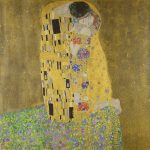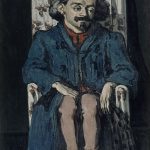Paul Cézanne, the iconic French painter, and Hortense Fiquet, his future wife and frequent model, first met in 1869. At that time, Cézanne was an emerging artist, still trying to find his unique voice in the art world. Hortense, working as a bookbinder, wasn’t initially connected to the art scene. Their meeting marked the beginning of a lifelong partnership, both personal and professional.
Cézanne and Hortense’s relationship started off rather quietly. The artist, known for his intense and often introverted nature, found a muse in Hortense that complemented his need for solitude and focus. Hortense’s calm and patient demeanor allowed Cézanne to work undisturbed, capturing her image over and over again. She became not only a supportive partner but also an essential part of his artistic journey.
Their early years together were filled with financial struggles and societal pressures. Cézanne’s family, particularly his father, was against the relationship. This disapproval forced the couple to keep their partnership secret for many years. Despite these challenges, their bond grew stronger, and Hortense’s unwavering support helped Cézanne persevere in his artistic endeavors.
Hortense played a crucial role in Cézanne’s life, both as a confidante and as an artistic subject. Her patience and willingness to sit for countless portraits allowed Cézanne to experiment with his style and technique. Over time, Hortense’s presence in Cézanne’s work became a testament to their enduring connection and her influence on his art.
Hortense as Cézanne’s Muse: The Artistic Collaboration
Hortense Fiquet was not just Cézanne’s wife but also his most frequent model. Throughout their relationship, Cézanne painted her more than 40 times. These portraits are now considered some of his most significant works, showcasing his evolving style and deepening understanding of form and color. Hortense’s steady presence provided Cézanne with a reliable subject to refine his artistic vision.
The portraits of Hortense reveal much about Cézanne’s approach to art. Unlike many artists who idealized their subjects, Cézanne captured Hortense with a raw honesty. He focused on the shapes, colors, and structures that made up her face and body, often giving his work a more abstract quality. This method was groundbreaking at the time and laid the groundwork for future artistic movements, including Cubism.
Hortense’s role as a model was demanding. Posing for long periods required immense patience and composure. However, her commitment to Cézanne’s work was unwavering. She understood the importance of her role in his creative process, and her dedication helped Cézanne push the boundaries of traditional portraiture. The resulting works are a blend of personal connection and artistic innovation.
Cézanne’s portraits of Hortense are notable for their emotional depth and complexity. Through these works, viewers can see the nuanced relationship between artist and muse. Cézanne’s intense focus and Hortense’s calm presence create a dynamic interplay that brings the portraits to life. Each painting is a testament to their collaboration and the unique bond they shared.
The Challenges of Their Relationship: Secrecy and Struggles
The relationship between Paul Cézanne and Hortense Fiquet was not without its difficulties. From the outset, they faced significant obstacles, particularly from Cézanne’s family. His father, a wealthy banker, disapproved of Hortense and the lifestyle Cézanne had chosen. This disapproval led to years of secrecy and financial instability, adding strain to their relationship.
Living under the constant pressure of secrecy was challenging for both Cézanne and Hortense. They often had to hide their relationship from the public eye and even from close friends. This secrecy took a toll on their personal lives, making it difficult to maintain a sense of normalcy. Despite these hardships, they remained committed to each other and their shared life.
Financial instability was another major challenge for the couple. Cézanne’s dedication to his art often meant that they lived in poverty. There were times when they struggled to afford basic necessities, adding stress to their daily lives. Hortense’s resilience and support were crucial during these difficult periods, helping Cézanne to continue pursuing his passion for painting.
The pressures of secrecy and financial hardship were compounded by Cézanne’s complex personality. He was known for his moodiness and intense focus on his work, which sometimes caused tension in their relationship. However, Hortense’s patience and understanding helped to balance these challenges, allowing them to maintain a strong bond despite the difficulties they faced.
Artistic Evolution: How Hortense Influenced Cézanne’s Work
Hortense Fiquet’s influence on Paul Cézanne’s work cannot be overstated. As his most frequent model, she played a key role in his artistic development. Cézanne’s early works featuring Hortense often depict her in a traditional, realistic style. However, as his style evolved, so did his portrayals of her, reflecting the changes in his artistic vision.
One of the most notable aspects of Cézanne’s portraits of Hortense is the way they capture her individuality. Unlike many artists of his time who idealized their subjects, Cézanne presented Hortense with all her unique features. This approach not only highlighted her character but also allowed Cézanne to explore new techniques in capturing the human form.
Cézanne’s evolving style is evident in his later portraits of Hortense. He began to use more abstract forms and vibrant colors, moving away from traditional realism. This shift in style was influenced by his desire to capture the essence of his subjects rather than their exact likeness. Hortense’s patience and willingness to sit for numerous portraits gave Cézanne the opportunity to experiment with these new techniques.
The evolution of Cézanne’s style can also be seen in the different moods and expressions captured in Hortense’s portraits. From serene and contemplative to somber and introspective, these works reveal the many facets of Hortense’s personality. Through these portraits, Cézanne was able to convey a deep emotional connection with his muse, showcasing the complexity of their relationship.
The Legacy of Their Partnership: Art and Beyond
Paul Cézanne and Hortense Fiquet’s partnership left an indelible mark on the art world. The numerous portraits of Hortense not only highlight Cézanne’s artistic evolution but also serve as a testament to their enduring bond. These works are now celebrated as some of Cézanne’s most important contributions to modern art, influencing countless artists and movements.
Hortense’s role as Cézanne’s muse extends beyond the canvases she inspired. Her presence in his life provided the stability and support he needed to push the boundaries of his art. Without her unwavering commitment, Cézanne might not have been able to achieve the same level of innovation and success. Hortense’s influence is woven into the fabric of Cézanne’s legacy, making her an integral part of his story.
The impact of Cézanne’s work, much of it featuring Hortense, can be seen in the development of modern art. His approach to form and color laid the groundwork for movements such as Cubism and Abstract Expressionism. Artists like Pablo Picasso and Henri Matisse drew inspiration from Cézanne’s techniques, further cementing his place in art history.
Today, the portraits of Hortense Fiquet are studied and admired by art enthusiasts and scholars alike. They provide a unique insight into the relationship between artist and muse, showcasing the profound impact that personal connections can have on creative work. Hortense’s legacy, as captured through Cézanne’s art, continues to inspire and influence the art world.
Conclusion
The story of Paul Cézanne and Hortense Fiquet is one of enduring love, artistic collaboration, and mutual support. Despite the challenges they faced, their partnership played a crucial role in the development of Cézanne’s unique style and his contributions to modern art. Hortense’s influence as a muse and her unwavering support were instrumental in Cézanne’s success, making her an integral part of his legacy.
As we look at the portraits Cézanne created of Hortense, we see more than just the evolution of an artist’s technique. We see the deep emotional connection between two individuals who, despite the odds, remained committed to each other and their shared journey. Hortense Fiquet, through her presence and patience, helped shape the course of Cézanne’s career, leaving a lasting impact on the art world.
Their story reminds us of the importance of personal connections in the creative process. The bond between Cézanne and Hortense was not just one of artist and model, but of two people who supported and inspired each other. This partnership, captured in the timeless portraits of Hortense, continues to inspire and resonate with audiences today.




